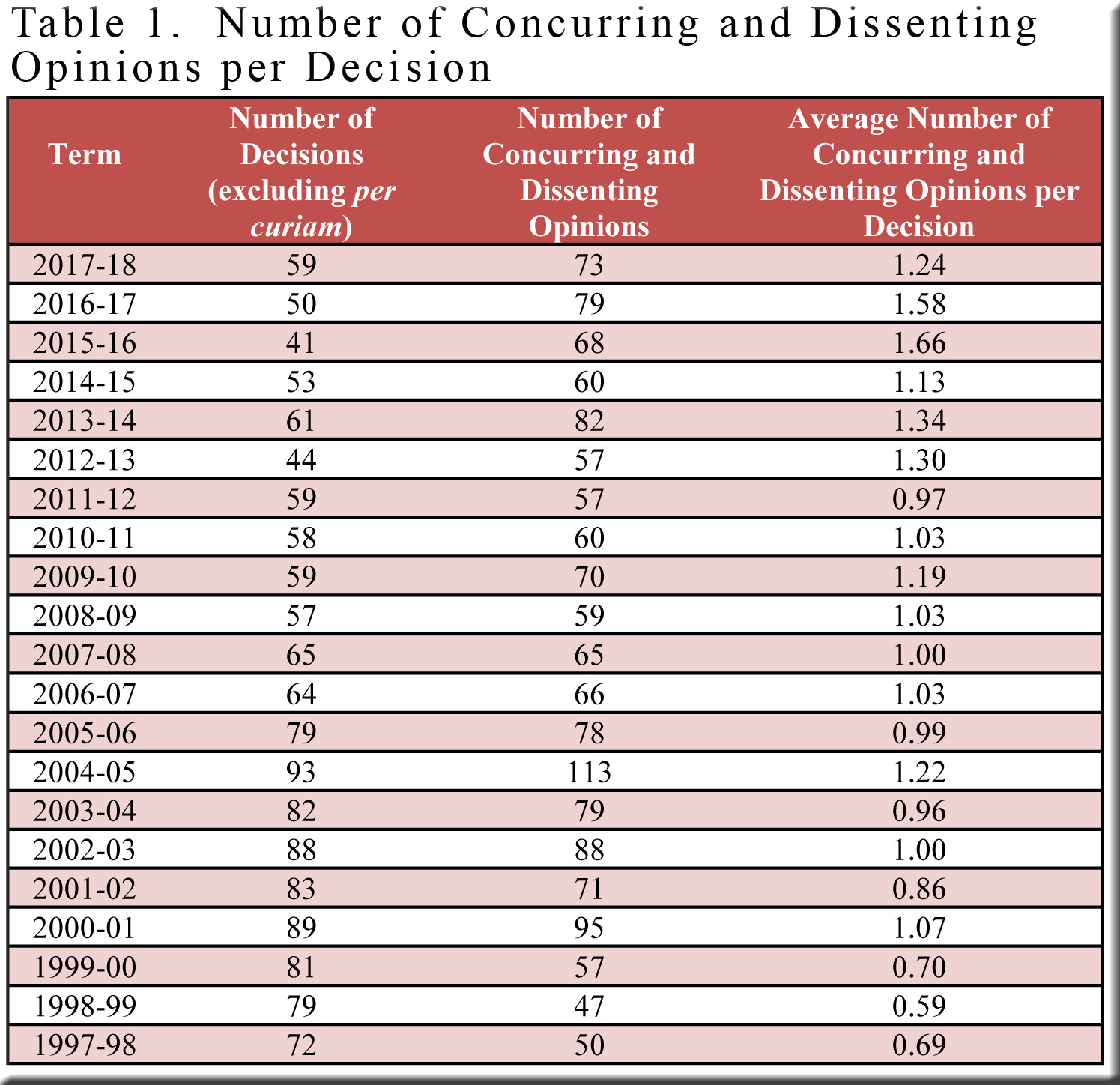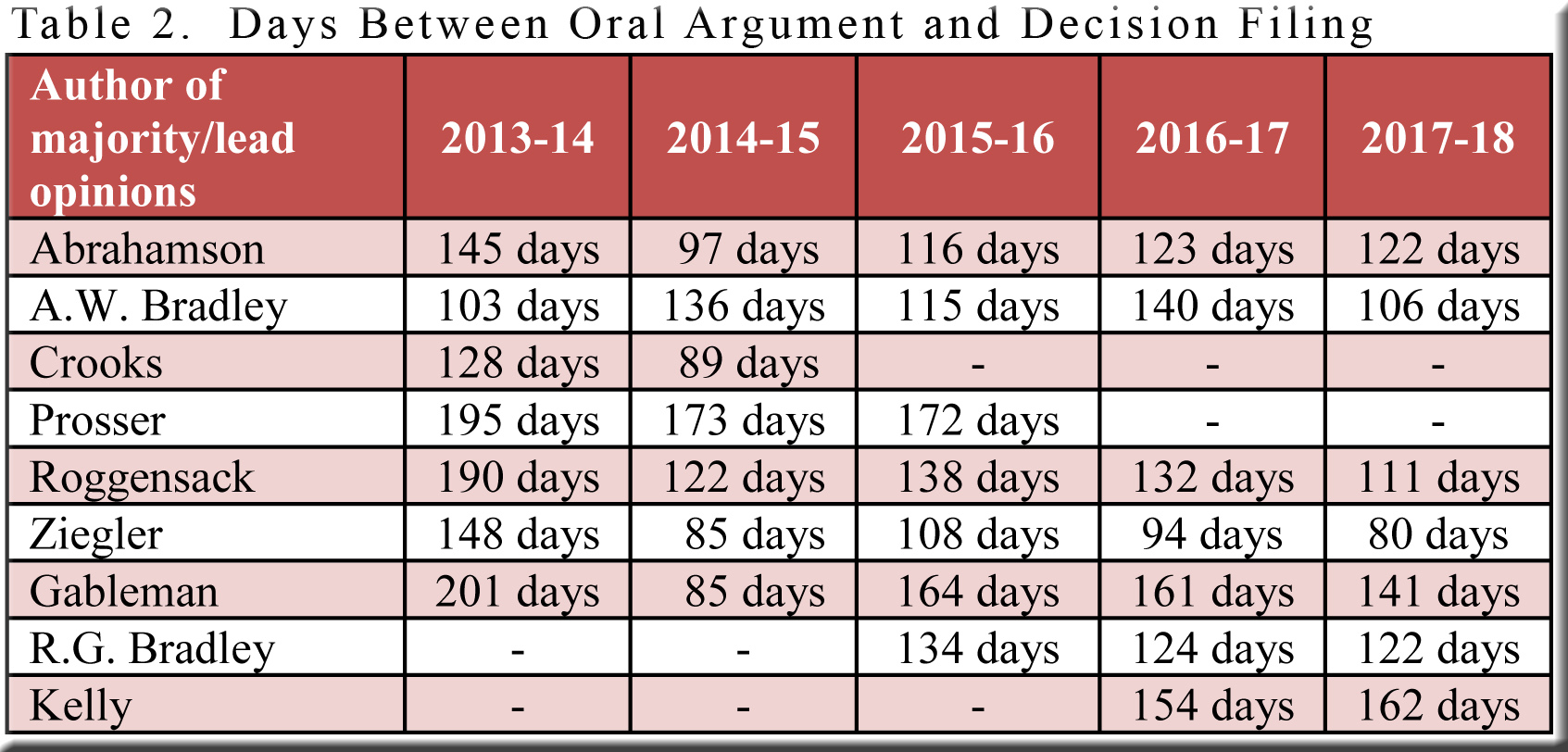With data for the 2017-18 term in hand, we can update our findings regarding three aspects of the justices’ work that SCOWstats has been following for several years: (1) the number of concurrences and dissents per decision, (2) the number of days between oral argument and decision filing, and (3) the number of pages per decision. In all three instances, the quantities decreased, thereby continuing—indeed, accelerating—declines that had begun the previous term.
Frequency of Separate Opinions
The frequency of concurrences and dissents has attracted attention now and then (even among the justices themselves), and it likely bears a relationship to a variety of other topics. The rate of separate opinions might correlate with the level of polarization on the bench, for example, and it certainly affects the other two issues before us today: the time taken to file decisions and the length of these decisions.
As displayed in Table 1, the rate of concurrences and dissents peaked in 2015-16 at 1.66 separate opinions per decision. The next year the figure retreated, but only slightly—dipping 5% to 1.58 separate opinions per decision. In 2017-18 the decline continued, and did so much more precipitously—a 22% drop to 1.24 separate opinions per decision.[1] This is still quite high compared to the majority of years covered in Table 1, especially the earlier years, but it is considerably closer to the norm than were the figures for the two preceding terms.
(click on graphs and tables to enlarge them)
Time Between Oral Argument and Decision Filing
In 2017-18, the justices averaged 120 days between oral argument and the filing of their decisions—down from 132 days in 2016-17. Although this 9% decline may not seem dramatic, it reduced the time between oral argument and decision filing to a level not seen at the Wisconsin Supreme Court for 15 years (with the exception of 2014-15, when the average plunged to 112 days from 162 days—and then rebounded). If, in 2018-19, the average again decreases by 9% (to 109 days), it would be lower than at any point since 1997-98, as shown in the following graph.[2]
For individual justices (Table 2), the averages vary a good deal—both from one year to the next and among justices in any single term. In 2017-18, for instance, Justice Ziegler’s majority/lead opinions were filed in only half the time required to file Justice Kelly’s.
Length of Decisions
Given the decline of both the rate of separate opinions and the time taken to file decisions in 2017-18, one would expect that decisions averaged fewer pages than in the previous term. Such was indeed the case, as demonstrated in the graph below.[3] The average length of a decision dropped 18%, from 55 pages to 45 pages.
Nearly all of this decline was accounted for by separate opinions, which shrank by 35% (from 23 pages to 15 pages per decision), while the average for majority/lead opinions nudged downward by only one page (Table 3).[4]
Conclusion
In all three areas, the movement of the figures evident in 2016-17 became more pronounced in 2017-18—less frequent separate opinions and faster filing of shorter decisions. If this trend continues for a third term in 2018-19, the revised graphs posted next summer will reach points not encountered for many years.
[1] Separate opinions that were coauthored are counted only once.
[2] Per curiam decisions are not included.
[3] The averages include title pages—but not the blank page that occurs at the end of each decision, nor appendices (which are very rare). Per curiam decisions are excluded.
[4] Title pages are not included in these averages. More specifically, I did not start the page count until the actual text of an opinion appeared—thus, occasionally, my count differs slightly from the count displayed in CCAP. Appendices and the blank page that occurs at the end of each decision are not counted. This is also the case for a supplemental table showing the average length of majority/lead opinions written by each justice.





Speak Your Mind